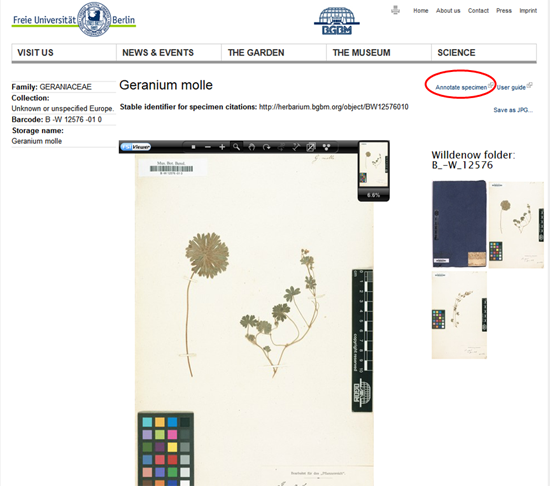GBIF-Deutschland präsentiert das neue Virtuelle Herbarium Deutschland. Das Virtuelle Herbarium ist eine gemeinschaftliche Präsentation bedeutender Herbarien Deutschlands und basiert auf modernster GBIF-Technologie. Virtuell bedeutet, dass Menschen aus Forschung, Bildung, Umweltwissenschaften sowie interessierte Bürgerinnen und Bürger digitalisierte Pflanzenbelege bequem am Rechner untersuchen können ohne die weiten Wege in die einzelnen Herbarien auf sich nehmen zu müssen.
You are here
Annotation system AnnoSys now online
AnnoSys allows users to provide corrections and additions to existing GBIF data (at present restricted to those using the ABCD data standard). AnnoSys can already be accessed through several web portals, check for example the Virtual Herbarium Berolinense (link top right) or the following BioCASe portals: the SYNTHESYS portal for European biodiversity data or the EDIT Specimen Explorer (link at the bottom of the web page).

Virtual Herbarium Berolinense connected to AnnoSys (Link: Annotate specimen)
Annotations are the result of scientific scrutiny and are an important quality control mechanism, improving the value of the physical collection object. Traditionally, individual specimens in collections are annotated in written form, with annotation labels being applied directly to the physical object. The annotation thus becomes part of the object and will be accessible to the next observer of the specimen. With much of the access to specimen data and images (as well as species occurrence records) now happening virtually, via the Internet, this information flow becomes disrupted. An online annotation mechanism is urgently needed in order to ensure continuing data sharing and incremental documentation of specimens and observation records.
AnnoSys is an annotation data repository which documents and safeguards improvements of data quality and makes them sustainably available. It includes back-end server functionality, web services and an on-line user interface. Secure system authentication and authorisation procedures have been implemented, including user roles and data privacy rules with respect to personal information of authors and users. Unlike simple annotation systems that allow only unstructured comments associated with records, AnnoSys also permits structured annotations of specific elements of a record. Annotations can be created by editing data that are present in the referring XML-document as well as by adding data for ABCD-standard elements not yet present in the record. For example, a user can provide a new identification, correct a species epithet or taxon author abbreviation, indicate the language for the name of a locality, or add the geographical coordinates. In principle, all data elements available in the ABCD standard can be edited, deleted, or newly added to the original record.
If a record has been annotated, both the annotation and the original record are stored in the AnnoSys repository, linked via a persistent identifier, and are accessible through the AnnoSys user interface and web service interfaces. The AnnoSys user-interface can be used to discover annotations. A search function allows searching and filtering the records in the repository using criteria like taxonomic groups, collection holders, collector´s names, collector´s numbers and annotation types (i.e. whether an annotation refers to the identification of the organism, the gathering event of the specimen, nomenclatural type designation, or “others”).
A subscription function is currently tested, which allows users specifically interested in a subset of data to subscribe to a corresponding topic in order to be informed about relevant annotations via AnnoSys' messaging system. For example, curators can subscribe to receive information about annotations to their collection, or taxonomists to the annotations referring to their taxonomic group from a specific geographic area. For testing this function and for testing the AnnoSys functionality without creating real annotations which will be visible in the portals, a sandbox is available on the project homepage.
Although in its current state AnnoSys is tailored for ABCD-collection data, the software solution is potentially format-independent, offering the opportunity for interoperable use in other biodiversity networks and their specific standards.
AnnoSys is developed by the AnnoSys project at the Botanic Garden and Botanical Museum Berlin-Dahlem (BGBM), funded by the German Research Foundation (DFG).
Link to AnnoSys publication: http://www.ingentaconnect.com/content/iapt/tax/2013/00000062/00000006/ar...
Link to project homepage: https://annosys.bgbm.fu-berlin.de/
Link to Sandbox: https://annosys.bgbm.fu-berlin.de/sandbox